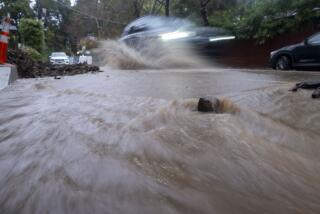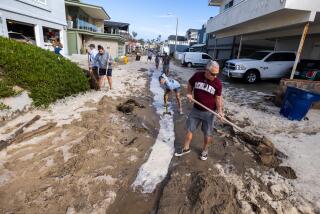County Steels Itself for Onslaught of El Nino
- Share via
The homeless have been moved from the river bottoms, storm drains and flood channels have been cleared and the county’s computer flood warning system has been tested.
Now it’s all over but the waiting.
“I think we’re ready,” said Laura Hernandez, assistant director for the county’s Office of Emergency Services. “We’re prepared for the worst, but we’re hoping for the best.”
Unless you’ve been hiding under a sandbag, you know that what county officials are preparing for is the ballyhooed, benignly named El Nino--”The Child” in Spanish.
“I think even we’re all probably a little tired of hearing about El Nino,” Hernandez acknowledged. “But at least all the media attention is making people aware of the threat. It’s pretty rare that we get this kind of forewarning about a disaster.”
El Nino, named after the Christ child because its warm ocean currents emerge off South America around Christmas, has in the past contributed to heavy rains in California.
Storms fueled by El Nino in the winter of 1982-83 caused $100 million in damage, according to the state Office of Emergency Services. Scientists predict this year could be worse, with rain totals triple their normal amounts.
State officials have held six regional briefings on El Nino preparations and plan two more before mid-December.
“If you know something is coming, you should take steps to prepare. It’s as simple as that,” said Bruce Ward, the assistant director of the Governor’s Office of Emergency Services.
In Ventura County the predicted storms could cause wave damage on the coast, flooding of streams and rivers, and mudslides on hillsides, officials said.
The county has planned for a variety of grim possibilities, from evacuating people threatened by torrents of mud in La Conchita to rescuing livestock stranded by flood waters.
Over the last few months, county officials have conducted flood warning exercises and held flood emergency workshops. In October, they staged a full-scale dry run of the emergency response system using a four-hour mock hurricane drill. To date, more than 300 county and city employees have gone through disaster training.
Because planning has been based mostly on experience, making a list of potential problems has been the equivalent of rounding up the usual suspects: La Conchita, the Ventura and Santa Clara rivers, areas above Fillmore and Piru burned by recent wildfires, the Pacific Coast Highway south of Mugu Rock, Calleguas Creek, Conejo Creek and Arroyo Simi.
Homeowners along the coast have invested in boards to shore up windows against heavy surf. Local officials have built sand berms along the beaches at Oxnard Shores and Silver Strand to protect homes.
“I think just looking at a map with the 100-year flood plain on it is a pretty good indicator,” said John Weikel, a senior engineer with the county Public Works Department.
Weikel said workers have unclogged most of the county’s flood control channels, debris basins and storm drains.
Even so, not much can be done to prevent flooding or mudslides if too much rain comes down too fast, said Dolores Taylor of the county’s Flood Control Department.
“But what we can provide is an early warning system,” she said.
Information is fed into county computers from more than 140 sensors placed across the county and in spots across the state. With improved technology, warnings of potential disasters are more accurate than ever, Taylor said.
To prepare for the deluge, workers have been checking the sensors and rain gauges to make sure they still work.
Improved forecasting gives local officials up to 12 hours’ warning before a major rainfall. The network of rain gauges and sensors can predict major flooding downstream, giving emergency workers up to 20 minutes’ notice, Taylor said.
Flood control officials know there will be street flooding and small stream flooding when more than seven-tenths of an inch of rain falls in the hills in an hour. If heavy sustained rain falls over three hours, downstream flooding is likely.
Mudslides occur after the soil is saturated with more than 10 inches of rain.
“My rule of thumb, learned over 27 years of experience, is that any time you have 10 inches or more in the east county or 14 inches or more in the west county you should start to worry about soil saturation and mudslides,” Taylor said.
More to Read
Sign up for Essential California
The most important California stories and recommendations in your inbox every morning.
You may occasionally receive promotional content from the Los Angeles Times.













